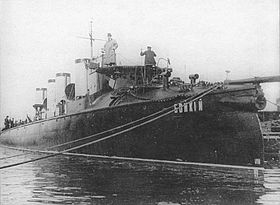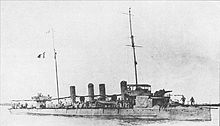Boiki (ship, 1902)
|
|
|
|---|---|
| Buini- class | |
 The boikiy |
|
| Overview | |
| Type | destroyer |
| units | 10 |
| Shipyard | |
| Keel laying | September 1900 |
| Launch | August 24, 1901 |
| Commissioning | July 5, 1902 |
| Whereabouts | scrapped after 1925 |
| Technical specifications | |
| displacement |
356 t, max. 440 t |
| length |
over everything: 65.4 m |
| width |
6.4 m |
| Draft |
2.8 m |
| crew |
66 men |
| drive |
4 Yarrow boilers |
| speed |
27.7 kn |
| Range |
1200 nm at 12 kn |
| Armament |
1 × 75 mm / L50 rapid fire gun |
The Boiki ( Russian Бойкий ) was a Russian torpedo boat destroyer who was in the service of the French Navy from 1918 to 1919 as Quentin Roosevelt .
Construction and technical data
The ship, one of ten boats of Buini class ( Russian Буйный class), was established in September 1900 at the Nevsky Shipyard in Saint Petersburg on down Kiel and ran there on August 11 jul. / August 24, 1901 greg. with the name Akula ( Russian Акула ) from the stack . The ship was on March 9th jul. / March 22, 1902 greg. renamed Boiki and put into service in August 1902.
It was 65.4 m long ( Lüa ), 6.4 m wide and had a 2.82 m draft . The water displacement was 356 tons standard or 440 tons fully equipped. The machinery consisted of four Yarrow boilers and two triple expansion steam engines with a total of 5700 hp . With two screws , it gave the ship a top speed of 27.7 knots . The range was 1200 nautical miles at a cruising speed of 12 knots. The crew consisted of 4 officers and 62 men. The boat was equipped with three 38.1-cm torpedo tubes , a 75-mm quick-firing gun L / 50, five 47-mm rapid-fire guns L / 43 and two 7.62-mm Hotchkiss - machine guns armed.
In 1907 the remaining boats in the class were classified as destroyers and in 1909 the armament of the boat was changed: it now had only two torpedo tubes and two 75 mm rapid-fire guns, but six 7.62 mm machine guns.
history
Russian Navy
On October 16, 1902, the Boiki sailed with her sister ship Burni ( Russian Бурный ) from Kronstadt with destination Port Arthur , but had to interrupt the voyage in Libau to have storm damage repaired. The two boats only reached Kiel on their way to the Far East at the beginning of November . At the beginning of December, the two boats finally found connection to the transfer association of Rear Admiral Stackelberg , which transferred two ships of the line , five cruisers and a total of seven torpedo boats from the Baltic Sea to East Asia to the Pacific Squadron . Stackelberg's ships hardly ever marched as a closed unit. After crossing the Suez Canal and the Red Sea , hot water pipes tore in the boilers on the Boiki at Perim , and she had to be towed to Port Arthur by the cruiser Bogatyr , which supported the torpedo boat association. Colombo was reached on March 7, 1903, Port Arthur on May 14, 1903 and the Boiki went straight to the shipyard there.
When the Russo-Japanese War began in February 1904, the boat was still in the shipyard. The work was not finished until May 2nd. The boat was then used for mine clearing and mine-laying operations , guard and security services and the occasional shelling of Japanese positions. After the naval battle in the Yellow Sea on August 10, 1904, the Boiki was among the Russian torpedo boats that returned to Port Arthur. As a result, she continued to be used for mine laying and as a guard ship. On November 7, 1904, Mikhail Andrejewitsch Berens , who later became admiral and commander in chief of the naval forces of the White Movement interned in Bizerta , became the commandant of the Boiki . On the night before the surrender of Port Arthur, he managed to break through the Japanese blockade with his ship and escape to Tsingtao , where the ship and crew were interned on January 4, 1905 .
In October 1905 the ship was returned to Russia, where it was then used in the Siberian flotilla . In 1909 the ship was completely overhauled, with its armament also being changed, as mentioned above. During the First World War , the Boiki provided routine service in the Far East until the October Revolution . In the fall of 1917, now accompanied the destroyer classified Boiki and Grosni ( Russian Грозный ) the cadet training ship Oryol ( Russian Орёл ) on a training ride with 120 cadets, while the Japanese Nagasaki by the October Revolution were surprised. On board the ships there were sometimes violent clashes with revolutionary sailors' committees. The squadron commander ignored the order to return to Vladivostok and finally marched with the three ships to Hong Kong , where he disembarked and evaded his responsibility for the small squadron. In June 1918, the three ships appeared in Vũng Tàu ( French Cap Saint-Jacques ). 80 of the cadets then continued their training in Indochina, and soon afterwards the commander of the Oryol offered to carry out freight services for the colonial administration with his ship as part of the payment of the resulting costs. The armament was removed and the ship then operated between Saigon and Hong Kong and even as far as Réunion .
French Navy
The Boiki was overhauled, taken into service on loan by the French Navy (as there were not enough Russian personnel available) and placed under the Navale d'Indochine division. In September 1918 it was renamed Quentin Roosevelt - in honor of Quentin Roosevelt , the son of the former US President Theodore Roosevelt who was shot down in his fighter plane on the Marne on July 14, 1918 .
Under the French flag, the Quentin Roosevelt then served in French Indochina , where after the end of the war, especially in Tonkin and Annam, anti-colonial and nationalist efforts were very active and were supported by sympathizers infiltrating from the southern Chinese provinces. The crew of the boat received the colonial medal with the clasp "Tonkin" in November 1921 for their work in the period from November 16, 1918 to June 20, 1919, when the ship cruised off the coast of Tonkin and the suppression of the rebellion in the district Bình Liêu supported.
Soviet Navy
On September 10, 1919, the boat was in conjunction with the re-armed Oryol passed to the Soviet government. It is said to have been launched in Vladivostok, then withdrawn from the list of ships of Soviet Russia on November 21, 1925 and then scrapped.
literature
- Gérard Garier: Les méconnus de la Marine nationale: les Quentin Roosevelt. In: Marines & Forces Navales , No. 93, Oct. – Nov. 2004, pp. 58-64.
- Bernhard Gomm: The Russian Warships 1856-1917, Volume IV: Torpedo cruisers, destroyers, submarines. Self-published, Wiesbaden 2000
- The Historical Section of the Committee of the Imperial Defense (Ed.): Official History (Naval and Militray) of the Russo-Japanese War . London 1910
Web links
Notes and individual references
- ↑ nzl.spb.ru
- ^ The ships of the line Retwisan and Pobeda , the cruisers Pallada , Diana , Nowik , Bogatyr and Bojarin as well as seven torpedo boats.
- ^ Archibald S. Hurd: The Battle of the Sea of Japan. In: The Fortnightly Review , Volume 78, July 1905, pp. 22-34 (34) .
- ^ The Historical Section of the Committee of the Imperial Defense (ed.): Official History (Naval and Military) of the Russo-Japanese War . tape 2 . London 1910.
- ^ Maurice Rives: La Marine en Indochine durant les Guerres Mondiales. In: Bulletin de l'ANAI , No. 9, Association Nationale des Anciens et Amis de l'Indochine et du Souvenir Indochinois, Paris, April 2007, pp. 5-13
- ↑ United States Naval Institute Proceedings. Volume 45, No. 197, July 1919 (p. 1245)
- ↑ Survol de l'Histoire de la Pénétration Française en Indochine (1625-1939). (PDF; 3.3 MB) p. 9
- ↑ france-phaleristique.com
- ^ Maurice Rives: La Marine en Indochine durant les Guerres Mondiales. In: Bulletin de l'ANAI , No. 9, Association Nationale des Anciens et Amis de l'Indochine et du Souvenir Indochinois. Paris, April 2007, pp. 5-13.
